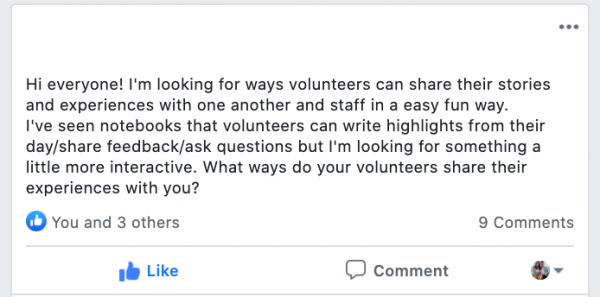Volunteer Coordinator Resource Community Recap Aug 4 - Aug 10
Volunteer newsletters always sound like a great idea in theory, but then after a month or two you feel like you are repeating yourself, or don’t have too much to write about. So, are volunteer newsletters worth it?
Many volunteer coordinators and managers weighed in on the topic last week in our Volunteer Coordinator Resource Community!
Especially in the times of COVID-19, volunteer newsletters are a great option to keep your volunteers in the loop and feel involved with the volunteer program even after programs have shut down.
Volunteer newsletters can be used for a multitude of reasons including:
Giving program and organizational updates
Boosting morale
Keeping communication with volunteers open
Reminding volunteers of upcoming events
No matter how you decided to use volunteer newsletters, the main idea is to be sure that the newsletter is being read and keeping volunteers informed and retained.

Have any ideas? Comment here!
Many volunteer programs are running out of ideas for their volunteer newsletters in COVID-19. But luckily, our Facebook group came to the rescue with unique volunteer newsletter and communication ideas.
Volunteer Newsletter Comments:
Do a “Volunteer of the Month” spotlight
“Education items, recipes, self -help ( taking care of one’s self). Silly cartoons, upcoming events in the hospital and community.”
“One thing I did while we were sheltering in place was find a different science quiz each week that I would send out (we're a science museum). They would let me know their score and they were entered into a raffle for a $10 Amazon gift card.”
“One idea I've used in the past is to have volunteers log in and update their profiles, as a way to keep them engaged. Then I know they're seeing their dashboard, opportunities, and will hopefully begin a shift to have more and more volunteers self-schedule (when applicable). Lots of our vols maybe never have logged in but they're eager to help - what a better way than making sure they're data is up to date.” We love this idea! Track It Forward is set up to have a customizable volunteer profile field, once volunteer managers set it up, volunteers can complete their profile and view their dashboard! You can even input unique questions in there for the volunteer to answer like “What is your favorite shelter in place activity?”
Virtual parties to catch up, you can send the dates out in the newsletter! You can also make these themed!
“I also include any updates on virtual programs, inviting them to participate. This week I sent them an invitation to like us on social media. If I have no news about our organization, I'll sent links to research on COVID or any social justice info. Educational resources are good, too. Anything to keep them engaged so they don't wander off.”
“I've continued doing a monthly newsletter to keep my volunteers engaged. I include photos and articles from staff and volunteers about what they've been up to. Both work-related and personal. Staff and volunteers are thankful for the opportunity to stay connected.”
“You can highlight vol of the month in a featured spotlight or share upcoming virtual events e.g. weekly community check-in, yoga night, online community dinner, happy hour, trivia etc.”
“We then had a short T/F quiz for them to submit. Everyone who submitted had their name entered in a drawing for a gift card. Easy way to provide ongoing education.”
Volunteer newsletters can easily be filled with tactics for volunteer retention and awards! Be creative with both your volunteer newsletters and with your volunteer program!
Resources on Volunteer Newsletters
Tracking Volunteer Drives
If you do food drives, clothing drives, donation drives- or any sort of collection program in your nonprofit, you may have a similar question!
How do you track volunteer drives?
 Read all the comments here.
Read all the comments here.
What other Volunteer Coordinators had to say:
“For food drives, we count the hours of our vetted volunteers that work on-site at the food bank or that pick up donations from a drop point in a company vehicle.”
“I use a Google doc and track by number of items, instead of hours. It's more for my records in case we want to highlight them at some point.”
“We only track volunteer hours if the drive involves extra volunteer time. For example, a group collected donations for Mother's Day gift bags. We didn't count the time it took for them to collect the donations, but we did ask them to estimate the time it took for them to put together the bags for all of our moms.”
With a multitude of ways to track donations and drives, we think it is most important to figure out why you want to track this information. Is it for a director? For writing a grant? Do you need to track hours, items, or both? Once you have this figured out, you should be able to focus more on how to do this.
Resources for Volunteer Tracking
Virtual Volunteer Interaction
A lot of people choose to volunteer for a social aspect. Virtual volunteering may be great, but how can you really incorporate that social aspect into your volunteering?
One Volunteer Coordinator in the Volunteer Coordinator Resource Community is trying to find a platform for volunteers to communicate with each other.
Creative Comments:
“I had them write profiles and then created a Canva template and shared on social media.”
Have volunteers send videos and add them to a shared drive
“Y’all I just checked out kudoboard for group posting and it’s pretty awesome. Not free but could be very engaging for lots of ideas.”
Start them a private Facebook Group!
 Last updated by
Last updated by 